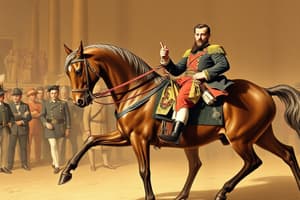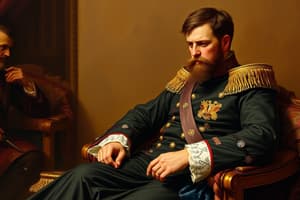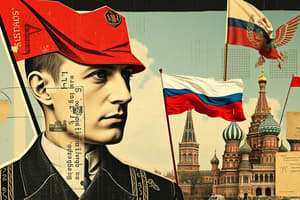Podcast
Questions and Answers
What was one of the key motivations for Alexander II to implement reforms?
What was one of the key motivations for Alexander II to implement reforms?
- To decentralize power from the tsar
- To increase the authority of the nobility
- To re-establish serfdom as a cornerstone of Russia
- To achieve strong and stable governance in Russia (correct)
Which part of the central government remained unchanged under Alexander II?
Which part of the central government remained unchanged under Alexander II?
- The Duma
- The Imperial Council of State (correct)
- The Ministry of War
- The Council of Noble Landowners
What role did the Senate play in the central government of Russia?
What role did the Senate play in the central government of Russia?
- Acted as the Supreme Court of Russia (correct)
- Served primarily as an advisory board
- Managed international diplomatic relations
- Oversaw all military operations
What happened to the first and second sections of the Personal Chancellery of his Imperial Majesty during Alexander II's rule?
What happened to the first and second sections of the Personal Chancellery of his Imperial Majesty during Alexander II's rule?
What was the main responsibility of the Council of Ministers under Alexander II?
What was the main responsibility of the Council of Ministers under Alexander II?
Which social institution was considered a cornerstone of autocratic Russia prior to Alexander II's reforms?
Which social institution was considered a cornerstone of autocratic Russia prior to Alexander II's reforms?
How did Alexander II's personal influence affect the reform process in Russia?
How did Alexander II's personal influence affect the reform process in Russia?
In the context of Alexander II's reforms, what is meant by 'relative success'?
In the context of Alexander II's reforms, what is meant by 'relative success'?
What was one primary restriction faced by Jews in Russia prior to 1855?
What was one primary restriction faced by Jews in Russia prior to 1855?
Which reform allowed Jewish merchants of the First Guild to live and trade throughout the Empire?
Which reform allowed Jewish merchants of the First Guild to live and trade throughout the Empire?
What did the Policy on Jewish Artisans, issued in 1865, primarily abolish?
What did the Policy on Jewish Artisans, issued in 1865, primarily abolish?
Why were the reforms of Alexander II seen as considerable progress by 1866?
Why were the reforms of Alexander II seen as considerable progress by 1866?
What was a notable reaction to Alexander II’s reforms among the intelligentsia?
What was a notable reaction to Alexander II’s reforms among the intelligentsia?
What was the underlying motivation behind Alexander II’s lifting of restrictions on Jews?
What was the underlying motivation behind Alexander II’s lifting of restrictions on Jews?
Following 1863, what trend occurred concerning legislation affecting Jews?
Following 1863, what trend occurred concerning legislation affecting Jews?
In terms of public reaction, how were Alexander II's reforms generally received initially?
In terms of public reaction, how were Alexander II's reforms generally received initially?
What was a significant weakness of the Committee of Ministers?
What was a significant weakness of the Committee of Ministers?
Which minister was responsible for domestic affairs?
Which minister was responsible for domestic affairs?
What did Alexander II's reforms regarding local government primarily aim to address?
What did Alexander II's reforms regarding local government primarily aim to address?
The zemstva had responsibilities in which of the following areas?
The zemstva had responsibilities in which of the following areas?
What was a major consequence of the zemstva's establishment?
What was a major consequence of the zemstva's establishment?
Which group had the highest representation in the district zemstva?
Which group had the highest representation in the district zemstva?
What fundamental change did the judicial reform of 1864 introduce?
What fundamental change did the judicial reform of 1864 introduce?
How were Justices of the Peace appointed under the new judicial reforms?
How were Justices of the Peace appointed under the new judicial reforms?
What was one of the goals of the zemstva according to the liberals?
What was one of the goals of the zemstva according to the liberals?
What role did the Chief procurator of the Holy Synod fulfill?
What role did the Chief procurator of the Holy Synod fulfill?
What did the zemstva fail to achieve, reflecting tensions between reform and autocratic control?
What did the zemstva fail to achieve, reflecting tensions between reform and autocratic control?
What was a significant issue within the Russian judicial system before the reforms?
What was a significant issue within the Russian judicial system before the reforms?
Which characteristic was NOT part of the judicial reform of 1864?
Which characteristic was NOT part of the judicial reform of 1864?
How did the membership of the zemstva reflect the involvement of the nobility?
How did the membership of the zemstva reflect the involvement of the nobility?
What was a notable outcome of the Vera Zasulich case in 1878?
What was a notable outcome of the Vera Zasulich case in 1878?
What was one significant change implemented under Miliutin's military reforms?
What was one significant change implemented under Miliutin's military reforms?
What was the initial length of military service for conscripts before Miliutin's reforms?
What was the initial length of military service for conscripts before Miliutin's reforms?
Which group faced increased resistance due to Miliutin's military reforms?
Which group faced increased resistance due to Miliutin's military reforms?
What was one of the unintended consequences of judicial reforms?
What was one of the unintended consequences of judicial reforms?
Which reform aimed to make the army less intimidating to potential conscripts?
Which reform aimed to make the army less intimidating to potential conscripts?
Who was appointed as Minister of Education to implement reforms after 1861?
Who was appointed as Minister of Education to implement reforms after 1861?
Which of the following best describes the attitude of juries during trials, as shown in the Vera Zasulich case?
Which of the following best describes the attitude of juries during trials, as shown in the Vera Zasulich case?
What aspect of the military was criticized prior to Miliutin's reforms?
What aspect of the military was criticized prior to Miliutin's reforms?
How did Miliutin's reforms address the notion of nobility in military service?
How did Miliutin's reforms address the notion of nobility in military service?
What were Junker schools established for?
What were Junker schools established for?
What was a main goal of the reforms in the education sector post-1861?
What was a main goal of the reforms in the education sector post-1861?
Which revolution was referenced as a model for Miliutin during his military reforms?
Which revolution was referenced as a model for Miliutin during his military reforms?
What attitude did Justices of the Peace sometimes exhibit?
What attitude did Justices of the Peace sometimes exhibit?
What was a consequence of the establishment of open and efficient courts?
What was a consequence of the establishment of open and efficient courts?
What was the main objective of placing new schools under the jurisdiction of the Ministry of Education in 1862?
What was the main objective of placing new schools under the jurisdiction of the Ministry of Education in 1862?
Which group of people were allowed to attend university lectures under the University Regulations of 1863?
Which group of people were allowed to attend university lectures under the University Regulations of 1863?
What significant change was made to the process of obtaining academic degrees under the University Regulations?
What significant change was made to the process of obtaining academic degrees under the University Regulations?
During whose reign was censorship the most extreme and harsh in Russia?
During whose reign was censorship the most extreme and harsh in Russia?
Which of the following was a key aspect of the Press Laws of 1865?
Which of the following was a key aspect of the Press Laws of 1865?
Who played a crucial role in the drafting of the University Regulations in 1863?
Who played a crucial role in the drafting of the University Regulations in 1863?
What was one of Reutern's significant contributions as Minister of Finance?
What was one of Reutern's significant contributions as Minister of Finance?
By the year 1866, how many miles of railway track had been laid in Russia?
By the year 1866, how many miles of railway track had been laid in Russia?
What significant change occurred in the teaching of law due to the University Regulations?
What significant change occurred in the teaching of law due to the University Regulations?
What was one of the main criticisms of censorship even after the Press Laws were enacted?
What was one of the main criticisms of censorship even after the Press Laws were enacted?
What support was offered to needy students under the University Regulations?
What support was offered to needy students under the University Regulations?
What was an outcome of the educational reforms from 1861 to 1881?
What was an outcome of the educational reforms from 1861 to 1881?
What was the purpose of the academic freedoms granted by the University Regulations?
What was the purpose of the academic freedoms granted by the University Regulations?
Which reform aimed to modernize the fiscal organization of Russia?
Which reform aimed to modernize the fiscal organization of Russia?
What was a potential consequence of the tightening of censorship in 1863?
What was a potential consequence of the tightening of censorship in 1863?
Flashcards are hidden until you start studying
Study Notes
Alexander II's Reforms
- Alexander II ascended the throne with the goal of achieving a strong and stable Russia.
- Serfdom was abolished in 1861 and Alexander II went on to push for reforms across various sectors of Russian society.
- Alexander II's reforms aimed at transforming the social and political system, including restructuring central government, local government, the legal system, military, education, censorship, and the economy.
Central Government
- Alexander II relied on assistance to organize and disseminate his will despite being an autocratic Tsar.
- Power remained with the Tsar, with every part of the central government ultimately accountable to him.
- Most of the central government structure remained unchanged.
- Key institutions included:
- The Third Section of the Personal Chancellery: Secret police.
- Imperial Council of State: provided legal and financial advice to the Tsar, but could be ignored.
- Council of Ministers: Appointed officials and discussed draft legislation.
- Senate: Supreme Court of Russia, acting as the final court of appeal, confirming titles of nobility, and resolving land ownership disputes.
- Changes in the central government:
- The First and Second Sections of the Personal Chancellery were abolished in 1861.
- The Committee of Ministers was established, consisting of thirteen ministers each with a responsibility for a specific area of Russian affairs.
- The four most important ministerial positions were:
- Minister of the Interior: domestic affairs, law and order
- Minister for War
- Minister of Finance
- Chief Procurator of the Holy Synod: religious affairs
- The ministers had an administrative role, they did not formulate policies and were ultimately accountable to the Tsar.
- A key weakness of the Committee of Ministers was a lack of inter-ministerial consultation leading to conflicting policies.
Local Government
- Alexander II implemented reforms to local government, aiming for greater efficiency but without appearing to yield to public pressure for reform.
- In 1859, calls for an independent judiciary, local government independent of the bureaucracy, and an elected body for economic affairs by nobles from the Tver province were suppressed.
- In 1862, nobles from the Tver province calling for a national assembly were imprisoned.
- The zemstva, local elected councils, were established in 1864.
- Powers of the zemstva:
- Public education, health, local economic development, road building, provision of services like water and fire prevention.
- The zemstva were two-tiered: district (uezd) and provincial (gubernia).
- Membership of the zemstva:
- District zemstva: 45% nobility, 40% peasants, 15% townsmen and clergy.
- The zemstva did not treat all groups equally, with local taxation continuing to favor the nobility over the peasantry.
- The zemstva's success in improving local administration demonstrated the people's capability, leading to arguments for extending representative principles to the central government.
Legal Reform
- The Russian judicial system was in need of reform due to inefficiency, corruption, and lack of training.
- The legal reform of 1864 sought to:
- Eliminate corruption and improve fairness through high salaries for judges, public trials, trial by jury, and appeal courts.
- Prioritize oral evidence and cross-examination in open court.
- The Judicial system had two tiers:
- Justices of the Peace: elected by district zemstva for three years.
- Judges: nominated by the Tsar and guaranteed independence.
- The Vera Zasulich case in 1878, a case where an admitted revolutionary was found not guilty, demonstrated the independence of the judiciary, despite ongoing limitations like administrative arrest and special courts for certain crimes.
- The reforms led to the creation of an independent bar, fostering a group of individuals trained in persuasion, knowledgeable about law and bureaucracy, and inclined towards liberal ideas.
- This contributed to the emergence of future revolutionaries.
Military Reforms
- The shortcomings of the Russian Military, evident in the Crimean War, were highlighted by its failure to defeat inferior foreign forces on Russian territory.
- The military's shortcomings were attributed to:
- Inflexible and inefficient administration and command structure.
- Severe and barbaric punishments.
- 25-year service for conscripts.
- Emphasis on parade ground performance over combat readiness.
- Miliutin, appointed Minister of War in 1861, focused on:
- Humanizing the military and improving efficiency.
- Decentralizing administration and supply through regional commands.
- Ending extreme corporal punishment and revising the Military Code.
- Establishing Junker schools open to all, fostering meritocratic selection over privilege and patronage.
- Reducing the length of compulsory service for conscripts.
- These reforms faced opposition from traditionalists and conservative elements, but the Prussian army's success in the Franco-Prussian War in 1870-71 provided a compelling case for reform.
Education
- Before 1861, education was strictly controlled.
- Golvonin, appointed Minister of Education in 1861, focused on expanding primary education through the zemstva and duma and freeing schools from the control of the Church.
- The University Regulations of 1863 granted universities:
- Virtual autonomy in administrative matters.
- Greater freedom in curriculum presentation and treatment.
- The right to import scholarly texts duty-free.
- Exemption from censorship for texts from foreign countries.
Censorship
- Censorship under Nicholas I was extreme, complex, and harsh.
- Alexander II initially relaxed censorship but tightened it in 1863.
- The Press Laws of 1865 relaxed censorship, allowing freedom from preliminary censorship for:
- All existing periodical publications in St Petersburg and Moscow, upon publisher request.
- Original writings over 160 pages.
- Government publications.
- Publications of academics, universities, and learned societies.
- Publications in ancient languages and translations from those languages.
- Sketches, diagrams, and maps.
- However, the Press Laws retained the power to issue warnings to publications, with a third warning leading to suspension for up to six months.
- While censorship remained stricter than modern Western standards, it was still a significant increase in freedom of ideas and expression compared to the previous regime.
Economic Reform
- Reutern, Minister of Finance from 1862 to 1878, focused on:
- Streamlining the fiscal organization of the state.
- Establishing a railway network, expanding from less than 700 miles of track to 2,194 miles by 1866.
- Developing and expanding financial institutions.
- Modernizing and streamlining the fiscal organization of the state.
Financial Institutions
- Between 1855 and 1878, there was a substantial increase in financial institutions in Russia.
- This increase was largely attributed to the policies of the Minister of Finance, Michael von Reutern.
- The Russian economy lacked access to capital, which hampered its growth. The growth of Financial institutions made this easier, but did not solve the problem.
Jewish Restrictions
- Jews in Russia faced significant restrictions in terms of their movement and trade.
- Until 1855, they were confined to the "Pale of Settlement", which restricted their ability to contribute to the Russian economy.
- Alexander II loosened these restrictions allowing Jewish merchants and soldiers to live and trade throughout the Empire.
- The most impactful change was the abolishment of the Pale for Jewish Artisans in 1865.
- This change was motivated by economic considerations, despite continuing anti-Semitism.
Alexander II’s Reforms
- The reforms undertaken by Alexander II, including those impacting the Jewish community, resulted in significant progress for Russia.
- These reforms faced challenges and resistance from various groups, including the Russian intellectuals.
- The intelligentsia were influential opinion leaders, and their opposition had a negative impact on Alexander II’s rule.
Studying That Suits You
Use AI to generate personalized quizzes and flashcards to suit your learning preferences.




